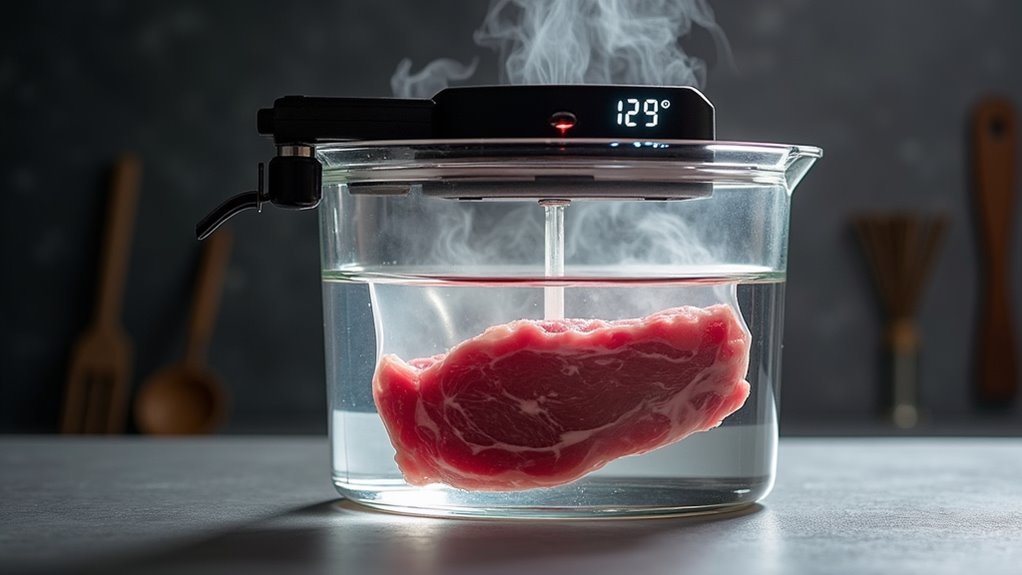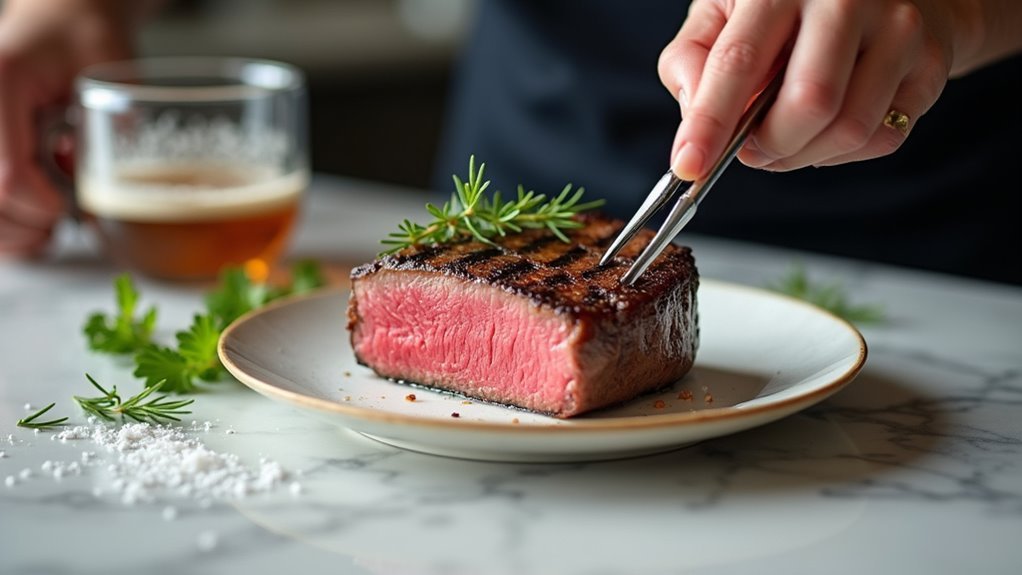Sous vide cooking transforms ordinary meals into restaurant-quality dishes with minimal effort. You’ll simply seal ingredients in a bag, immerse them in precisely controlled water, and let science do the work. The magic happens at specific temperatures where proteins transform perfectly while retaining moisture and flavor. All you need is an immersion circulator, food-grade bags, and a container – no culinary degree required. Finish with a quick sear, and you’ll discover why chefs have been keeping this technique their secret weapon.
The Science Behind Perfect Temperature Control

When delving into the science of sous vide cooking, it’s important to understand why temperature control is the cornerstone of this revolutionary technique. Unlike traditional methods where heat fluctuates wildly, sous vide maintains precise temperatures throughout the cooking process.
You’re probably wondering why this matters. Well, proteins undergo significant changes at specific temperatures – not ranges. When you cook a steak at exactly 131°F, you’re targeting the perfect point where collagen begins to break down but moisture remains locked in.
I think what’s most fascinating is how this precision eliminates guesswork. You’ll never overcook anything again, which is perhaps the greatest gift sous vide offers home cooks. The ability to control cooking temperatures so accurately ensures that your steak reaches the perfect doneness while preserving its juiciness.
Essential Equipment for Sous Vide Success
I’ve found that a quality immersion circulator like the Anova or Joule genuinely makes all the difference in temperature precision.
You’ll also need some decent food-grade bags – vacuum sealers are great, but honestly, the water displacement method with ziplock bags works perfectly fine for beginners.
Perhaps the most overlooked item is a good container with a lid to prevent evaporation during those longer cooks.
Don’t forget a cast iron skillet for that final sear! It’s essential.
Additionally, investing in a good vacuum sealer can enhance your sous vide experience by ensuring even temperature distribution and preserving the quality of your ingredients, especially when using vacuum sealers for sous vide.
Step-by-Step Guide to Your First Sous Vide Meal
Ready to plunge into your first sous vide cooking adventure? It’s simpler than you might think! Just follow these basic steps and you’ll be enjoying restaurant-quality meals at home in no time. Sous vide cooking preserves nutritional value and enhances the flavor of your ingredients for optimal results.
| Step | Time | Key Action |
|---|---|---|
| Prep | 5-10 min | Season food, place in bag using displacement method |
| Cook | Varies | Set temperature, submerge bag, wait patiently |
| Finish | 1-2 min | Pat dry, sear quickly in hot cast iron skillet |
Beyond the Basics: Advanced Sous Vide Techniques

Once you’ve mastered the basics of sous vide cooking, you’ll probably start wondering what else you can do with this versatile technique. The possibilities are actually pretty endless!
Try experimenting with infusions – herbs, spices, and aromatics penetrate meats beautifully during long baths. You might also explore multi-stage cooking. Perhaps sear first, then sous vide, then finish with a torch? I think that combination creates layers of flavor you just can’t get otherwise.
And don’t limit yourself to proteins – sous vide vegetables retain incredible color and texture when cooked at precisely 183°F. Sometimes I even use it for desserts! Additionally, sous vide cooking allows for achieving perfectly cooked meat consistently, ensuring every dish is a culinary success.
Frequently Asked Questions
Can You Reuse Sous Vide Water Between Cooking Sessions?
You can reuse sous vide water between sessions if it remains clean. For food safety, discard water if there’s leakage. Change it weekly for regular users to prevent buildup.
Is It Safe to Sous Vide Frozen Meat Without Thawing?
Yes, you can safely sous vide frozen meat without thawing. You’ll just need to add about 50% more cooking time to guarantee proper temperature penetration throughout the protein.
How Do You Prevent Floating Bags During Cooking?
Just as life often needs a little weight to stay grounded, you’ll prevent floating sous vide bags by using the water displacement method, adding weights, or using sous vide balls/clips that secure bags to container edges.
Can Sous Vide Cooking Reduce Food Waste?
Yes, sous vide cooking can reduce food waste. You’ll preserve more nutrients, extend food shelf life, and cook precisely, ensuring you don’t overcook or burn meals that would otherwise be discarded.
What Should I Do if My Sous Vide Machine Malfunctions Mid-Cook?
If your sous vide machine fails mid-cook, check if your food reached a safe temperature. You can finish cooking using alternative methods like stovetop simmering or oven baking at similar temperatures.
